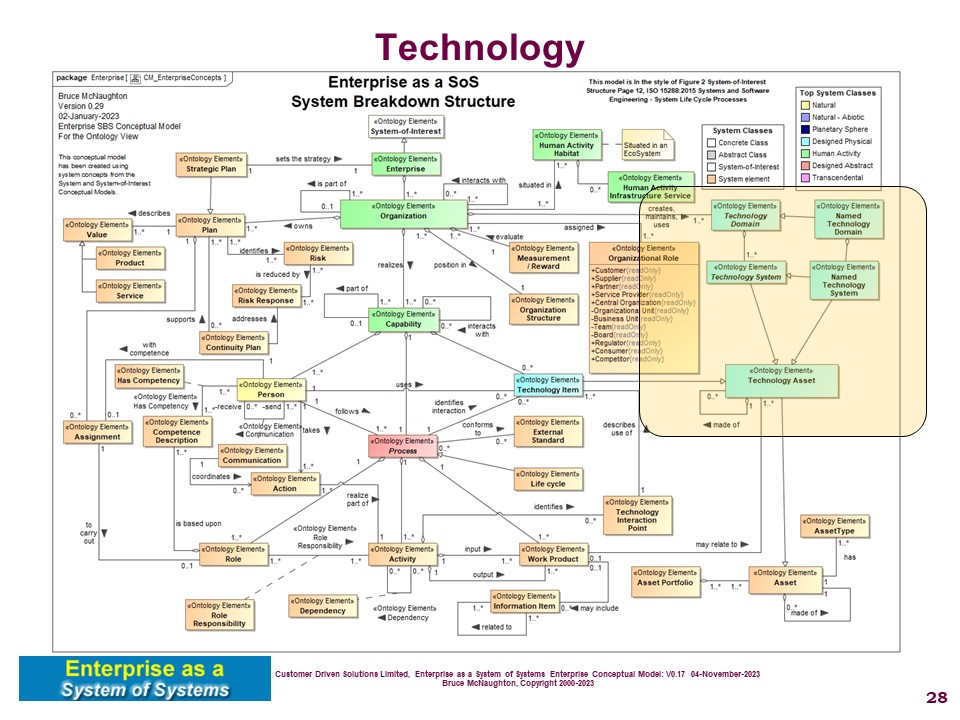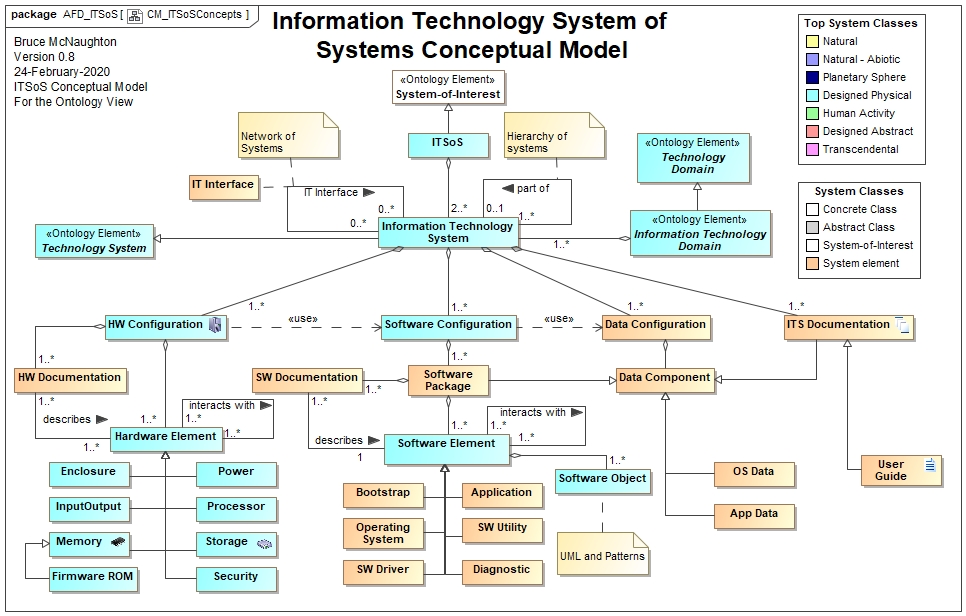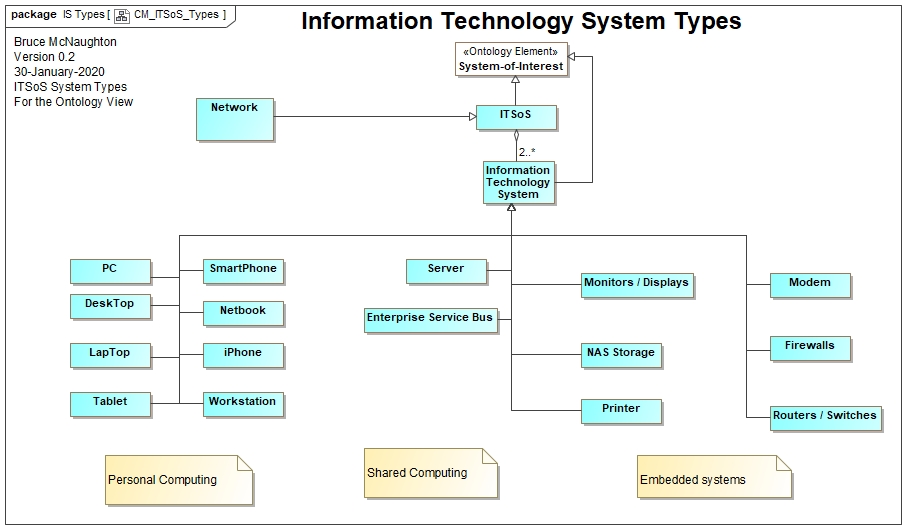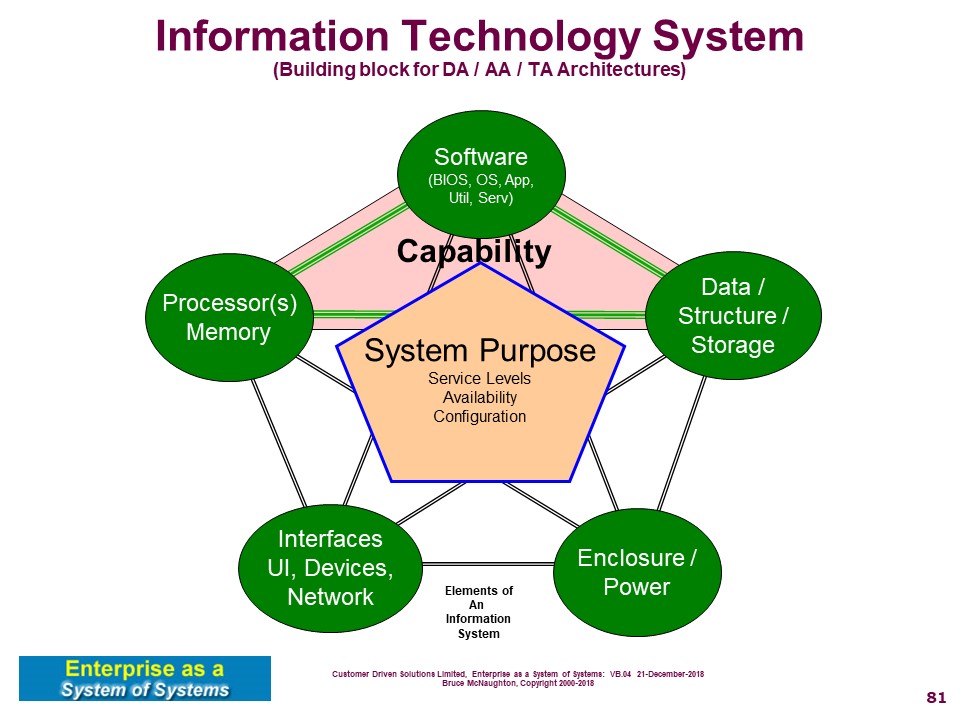System: Information Technology System of Systems (SoS)
System concepts are being applied to this system-of-interest within this System Description.
Name: Information Technology System of Systems (SoS)
Based on: Technology System.
A Technology Item is a system element within the Capability. An Information Technology item supports the automation of a capability by improving the effectiveness and the efficiency of the capability.
Technology refers to a type of engineered or designed system that an organization is responsible for. The organization will be responsible for the relevant parts of the technology life cycle.
Information Technology is the general sector of technology that applies to the information technology system.
NOTE: A specific Architecture Viewpoint Definition and associated conceptual models will be created to establish an Information Technology Archtiecture Framework. This has not started. The model above is a starting point for this work. Other existing architecture description frameworks will also be used in the creation of the AFD.
NOTE: Information Technology Systems may also have a role within other technology systems. These are typically called embedded information technology systems. These types of systems can also use the same information technology architecture description framework and similar development life cycles.
The purpose of an Information Technology System is to help people carry out their work and achieve their objectives within an organization. Productivity and efficiency improvements using technology are the key focus. The information technology system must be fit for purpose within the realization of an organizational capability.
Systemic Measurable Variables
The key measurable variables for technology are:
Performance
- Computational speed
- Transfer speed
- Volume of calculations
- Time to change / improve
Usability
- Cost of training and learning
- Time saved by using the solution
- Reduction in errors
Systemic Capabilities or Functions
The capabilities of the Information technology
- Specific functions to automate activities within a process.
- Ability to collaborate and work in teams in near real time.
- Continued operation during faults or incidents.
System States
An information system has the following states:
- Proposed
- Planned and Designed
- Developed
- Tested
- Operational
- Retired
(to be defined as part of the development of the CAFF for the Information Technology System of Systems (SoS)and in the Information Technology System of Systems (SoS) architecture description framework:
Systemic Quality Properties
System Quantity Properties
Manager
- Are the tools improving the productivity of the people in the team?
- Do I have sufficient quantities of tools to achieve our objectives / targets?
People
- Do I understand the purpose and how to use any technology?
- Do I have the skills, knowledge and experience to carry out the work using the tools?
- Is the information system easy to use?
- Do I value the information system as a means to achieve my objectives?
Information Technology Systems form part of the Information Technology Systems needed for the enterprise. This information technology may be a subset of the entire set of technology used within an organization.

Information Technology Systems can be either COTS (Commercial off the shelf - typically black box) or developed within the organization (typically white box). The information technology system in use becomes an asset of the organization.
An information system fits within the full set of information systems used in a Organization. The total set of information systems is identified in the Information Technology Architecture Description. The network viewpoint highlights the number and types of information systems used in an organization.
The environment for the information technology systems is both the full set of technology inside the enterprise and the specific technology used within a Organization. Other factors outside of the enterprise include:
- Rate of technology change
- Requirements and external standards that must be met
- Security and continuity requirements external to the enterprise.
An information system is the basic building block in the Information Technology System of Systems (SoS).
System Element: Identification

With the following Information Technology System types (initial list):

System Element: Identification and Relationships
The following is a picture of an information system. This is a fractal model similar to the team model and is a fundamental building block for the information Technology architecture description framework. This diagram shows the interactions of the various system elements within an Information Technology System.

- Purpose
- Enclosure / power
- Processor / Memory
- Software
- Data Storage
- Interfaces
The full collection of information systems used in an organization form the Information Technology System of Systems (SoS).
NOTE: The technology aspects of this website will be developed at a later time. See TOGAF for the domains of application, data, and infrastructure for an approach to this full Information Technology System of Systems (SoS).
Configuration / Scenario:
Describes any configuration / scenario attributes for a specific system-of-interest. This may not be appropriate for all system descriptions (e.g. patterns or abstract systems).
Cyclical (Repeating / Regular) Processes
The functions provided by the IT systems determine the fit of the system within the operational capabilities of the organization. These functions provide value to the people to carry out the process activities necessary for the capabilities.
Development Life Cycle Processes
Information systems may either be commodity products acquired through the procurement process or created specifically for the organisation using various new product / service development capabilities..
The architecture and design of an information system is handled through the Information Systems Innovation Life Cycle. Capabilities using this life cycle translate the requirements / needs as identified in the business process and the team management plans and create a tested and fit for purpose information system that supports the performance needs of the capability.